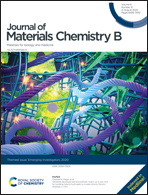Effect of conjugated (EK)10 peptide on structural and dynamic properties of ubiquitin protein: a molecular dynamics simulation study†
Abstract
Peptide conjugation modulates the stability and function of enzymes and therapeutic proteins. It remains unclear how the attached peptides influence the properties of the original protein. To shed light on this question, this work investigates the structural and dynamic properties of two model protein–peptide conjugates: (glutamic acid-lysine)10-N-ubiquitin and ubiquitin-C-(glutamic acid-lysine)10 using molecular dynamics simulations. The effect of the conjugated peptide on the properties of ubiquitin protein is investigated by analysing the root mean square deviation (RMSD) and root mean square fluctuation (RMSF) of Cα atoms on amino acid residues, the secondary structure of amino acid residues, solvent accessible surface area of protein regions and residue–residue distance. The simulation results show that the N-terminal and C-terminal conjugated peptides maintain the stability of the ubiquitin protein at room temperature and enhance its ability to resist the denaturing effect of high temperature. The simulations also show that the conjugated peptide can adjust the secondary structures of distant amino acid residues via the allosteric effect. This work further discusses the effect of such a change in the secondary structure of amino acid residues on the function of the ubiquitin protein. The simulations show the importance of the anchoring position and allosteric effect of the conjugated peptide on its ability to influence the stability and function of the protein.

- This article is part of the themed collection: Journal of Materials Chemistry B Emerging Investigators


 Please wait while we load your content...
Please wait while we load your content...